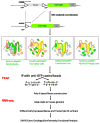Defining the acute kidney injury and repair transcriptome
- PMID: 25217269
- PMCID: PMC4163949
- DOI: 10.1016/j.semnephrol.2014.06.007
Defining the acute kidney injury and repair transcriptome
Abstract
The mammalian kidney has an intrinsic ability to repair after significant injury. However, this process is inefficient: patients are at high risk for the loss of kidney function in later life. No therapy exists to treat established acute kidney injury (AKI) per se: strategies to promote endogenous repair processes and retard associated fibrosis are a high priority. Whole-organ gene expression profiling has been used to identify repair responses initiated with AKI, and factors that may promote the transition from AKI to chronic kidney disease. Transcriptional profiling has shown molecular markers and potential regulatory pathways of renal repair. Activation of a few key developmental pathways has been reported during repair. Whether these are comparable networks with similar target genes with those in earlier nephrogenesis remains unclear. Altered microRNA profiles, persistent tubular injury responses, and distinct late inflammatory responses highlight continuing kidney pathology. Additional insights into injury and repair processes will be gained by study of the repair transcriptome and cell-specific translatome using high-resolution technologies such as RNA sequencing and translational profiling tailored to specific cellular compartments within the kidney. An enhanced understanding holds promise for both the identification of novel therapeutic targets and biomarker-based evaluation of the damage-repair process.
Keywords: Acute kidney injury; TRAP; cancer; development; miRNA; repair; transcriptome.
Copyright © 2014 Elsevier Inc. All rights reserved.
Figures



Similar articles
-
Cellular and molecular pathways of renal repair after acute kidney injury.Kidney Int. 2018 Jan;93(1):27-40. doi: 10.1016/j.kint.2017.07.030. Kidney Int. 2018. PMID: 29291820 Review.
-
Cell profiling of mouse acute kidney injury reveals conserved cellular responses to injury.Proc Natl Acad Sci U S A. 2020 Jul 7;117(27):15874-15883. doi: 10.1073/pnas.2005477117. Epub 2020 Jun 22. Proc Natl Acad Sci U S A. 2020. PMID: 32571916 Free PMC article.
-
Recent Insights into Kidney Injury and Repair from Transcriptomic Analyses.Nephron. 2019;143(3):162-165. doi: 10.1159/000500638. Epub 2019 May 21. Nephron. 2019. PMID: 31112966 Free PMC article. Review.
-
Meta-analysis of polycystic kidney disease expression profiles defines strong involvement of injury repair processes.Am J Physiol Renal Physiol. 2017 Apr 1;312(4):F806-F817. doi: 10.1152/ajprenal.00653.2016. Epub 2017 Feb 1. Am J Physiol Renal Physiol. 2017. PMID: 28148532
-
Non-coding RNAs in kidney injury and repair.Am J Physiol Cell Physiol. 2019 Aug 1;317(2):C177-C188. doi: 10.1152/ajpcell.00048.2019. Epub 2019 Apr 10. Am J Physiol Cell Physiol. 2019. PMID: 30969781 Review.
Cited by
-
Does Renal Repair Recapitulate Kidney Development?J Am Soc Nephrol. 2017 Jan;28(1):34-46. doi: 10.1681/ASN.2016070748. Epub 2016 Oct 26. J Am Soc Nephrol. 2017. PMID: 27798243 Free PMC article. Review.
-
The Intersection of Acute Kidney Injury and Non-Coding RNAs: Inflammation.Front Physiol. 2022 Jun 9;13:923239. doi: 10.3389/fphys.2022.923239. eCollection 2022. Front Physiol. 2022. PMID: 35755446 Free PMC article. Review.
-
Segment specific loss of NFAT5 function in the kidneys is sufficient to induce a global kidney injury like phenotype.FASEB J. 2025 Jan 31;39(2):e70352. doi: 10.1096/fj.202402497R. FASEB J. 2025. PMID: 39874047 Free PMC article.
-
Effect of Triiodothyronine Administration on the Kidney During Haemorrhagic Shock and Resuscitation.Turk J Anaesthesiol Reanim. 2020 Oct;48(5):406-413. doi: 10.5152/TJAR.2019.81542. Epub 2020 Feb 5. Turk J Anaesthesiol Reanim. 2020. PMID: 33103146 Free PMC article.
-
Insights into Repeated Renal Injury Using RNA-Seq with Two New RPTEC Cell Lines.Int J Mol Sci. 2023 Sep 18;24(18):14228. doi: 10.3390/ijms241814228. Int J Mol Sci. 2023. PMID: 37762531 Free PMC article.
References
-
- Waikar SS, Liu KD, Chertow GM. Diagnosis, epidemiology and outcomes of acute kidney injury. Clinical journal of the American Society of Nephrology: CJASN. 2008;3:844–61. - PubMed
-
- Chertow GM, Burdick E, Honour M, Bonventre JV, Bates DW. Acute kidney injury, mortality, length of stay, and costs in hospitalized patients. Journal of the American Society of Nephrology: JASN. 2005;16:3365–70. - PubMed
Publication types
MeSH terms
Grants and funding
LinkOut - more resources
Full Text Sources
Other Literature Sources
Medical

